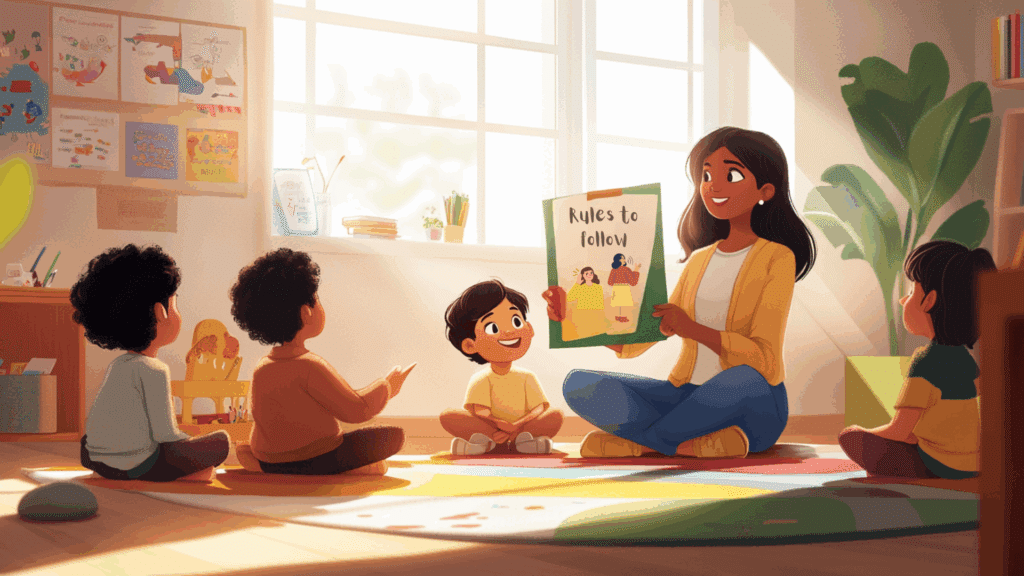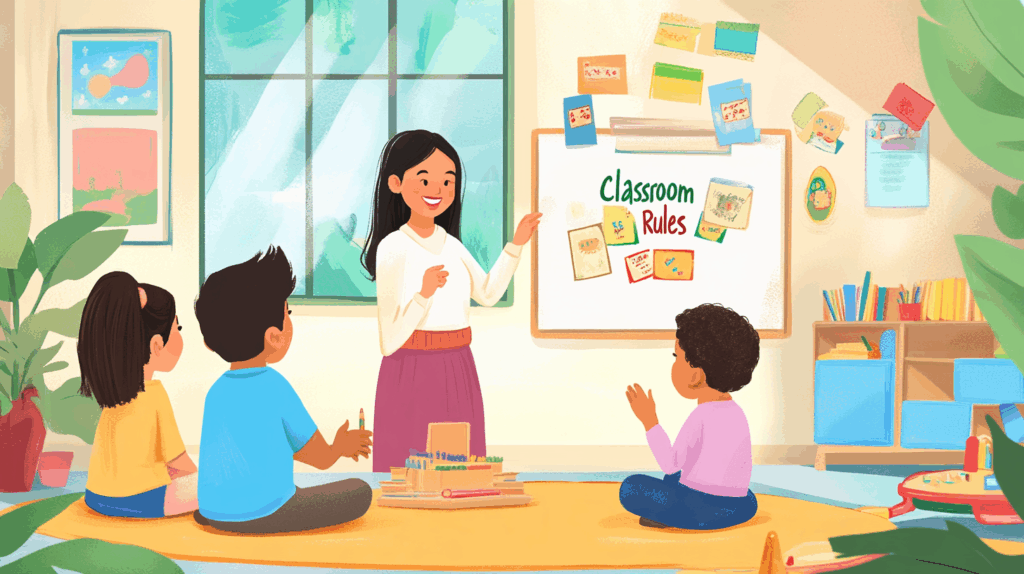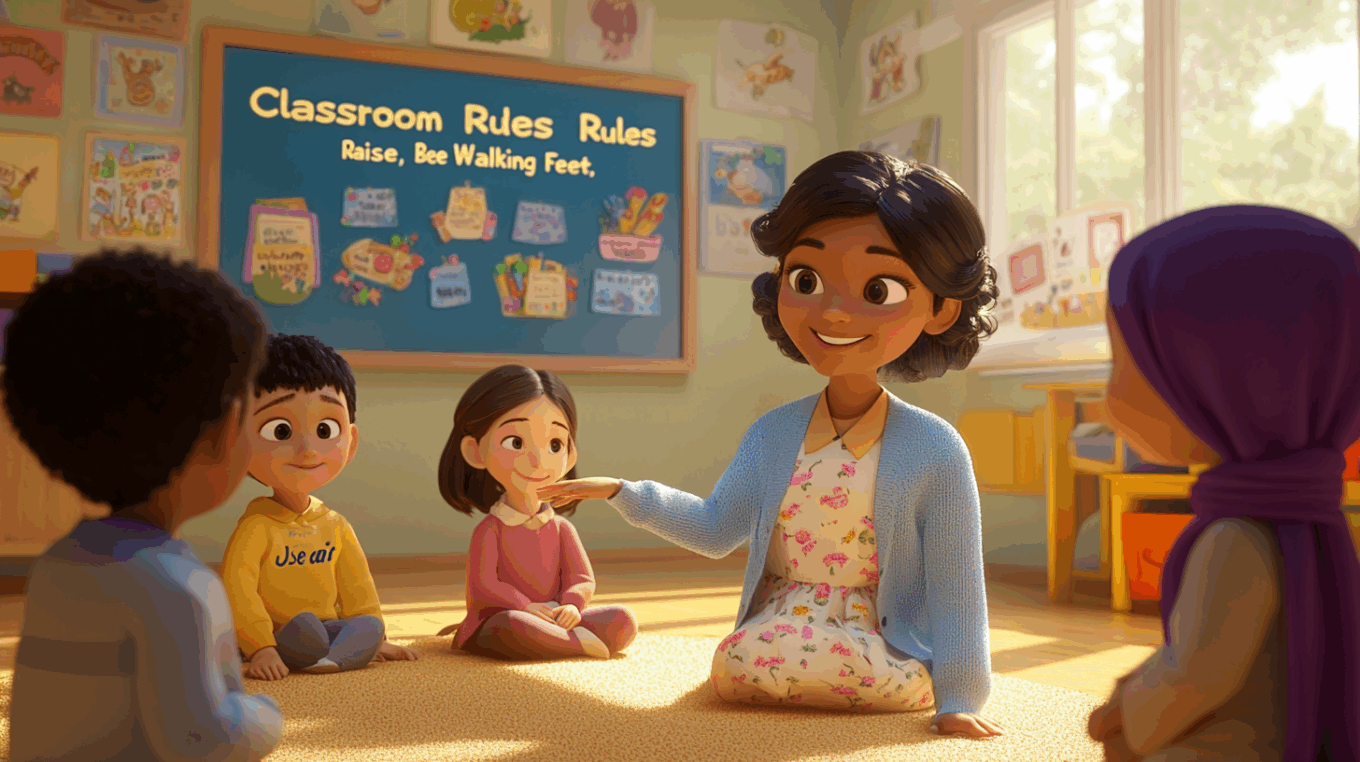Do you feel lost when trying to keep order in a kindergarten classroom? You’re not alone.
Many teachers struggle with getting young children to follow basic rules. But classroom rules for kindergarten don’t have to be hard to teach.
The right rules, taught in simple ways, can make a big difference in how well children learn and behave.
In this blog, we’ll look at why rules matter, the ten most important classroom rules for kindergarten, and easy ways to teach these rules.
We’ll also share tips for making rules work in classrooms with children from different backgrounds. With these tools, you can create a calm, happy place where all children can learn.
Why Kindergarten Rules Matter?
Rules in kindergarten help young children learn basic life skills. Kids who follow classroom rules tend to do better in school later on.
Structure helps children feel safe and know what to expect each day. When children learn to follow rules early, they build good habits for the future.
Rules also teach kids how to get along with others and show respect. These skills help them grow into responsible students.
Following rules also helps children learn self-control and how to be part of a group, which are important skills for success in life.
Core Rules Every Kindergarten Classroom Needs

Clear rules make the classroom run smoothly and help children learn better. These ten basic rules form the building blocks of good behavior that children can use throughout their school years.
1. Listen and Do
When teachers give instructions, students need to pay attention and follow through. This skill helps children complete tasks correctly and learn new things.
Good listeners make fewer mistakes and understand more. Teachers can spot which students need extra help when everyone tries to listen first.
This rule also helps kids learn to focus, which they’ll need for all future learning. Active listening is a skill that will help children succeed in all areas of their education.
2. Use Your Walking Feet
Safety comes first in a kindergarten classroom. Walking instead of running stops many accidents before they happen.
Children need to move carefully around tables, chairs, and other students. This rule helps keep everyone safe and teaches children to think about how their actions affect others.
It also helps maintain a calm classroom where learning can happen. When children walk calmly, they set a good example for their classmates to follow.
3. Raise Your Hand to Speak
Taking turns to talk helps everyone get a chance to share their thoughts. When everyone speaks at once, no one can hear or learn.
Hand raising teaches patience and respect for others who are talking. This system helps shy children get a turn, too.
It shows children that everyone’s ideas matter and deserve to be heard without interruption. Learning to wait for your turn to speak is a valuable social skill that extends beyond the classroom.
4. Respect Personal Space
Each child needs their own space to work and learn. Not crowding others helps everyone feel comfortable in the classroom.
Children learn that other people have boundaries that should not be crossed. This rule helps reduce conflicts between students and creates a peaceful place to learn.
It also teaches children to be aware of those around them. Understanding personal space helps build the foundation for healthy relationships in the future.
5. Be Kind and Share
Sharing toys, books, and supplies helps build friendship skills. Children learn that working together makes activities more fun.
Being kind includes using nice words, helping others, and taking turns. These actions create a happy classroom where children want to be.
When kids see that sharing helps everyone, they start to think of others more. The habit of kindness formed in kindergarten can last a lifetime and spread to others.
6. Use Inside Voices
Loud noises make it hard to think and learn. Using quiet voices in the classroom helps everyone concentrate.
Children learn to adjust their volume based on where they are and what they’re doing. This skill shows respect for others who are trying to work.
It also helps teachers give clear instructions without having to shout. Learning voice control is an important part of social awareness that children will use in many settings.
7. Keep Hands and Feet to Yourself
This rule stops pushing, hitting, and kicking before they start. Children learn that touching others without permission isn’t okay.
This basic rule prevents most physical conflicts in the classroom. It shows respect for other people’s bodies and comfort.
Children feel safer when they know this rule will be enforced by teachers. This rule lays the groundwork for understanding consent and physical boundaries as they grow older.
8. Follow Directions Quickly
When children respond to instructions right away, more learning can happen. Quick action is also important for safety in case of fire drills or emergencies.
This rule teaches children to trust their teachers and act when asked. It helps the whole class move through activities smoothly.
Children who follow directions well tend to learn more during the school day. This skill transfers to home life too, making daily routines easier for families.
9. Use Kind Words
The words we choose affect how others feel. Children need to learn that mean words can hurt just like hitting.
This rule helps create a classroom where everyone feels welcome and liked. Using nice words builds friendships and solves problems.
It teaches children to express their feelings without being mean or hurtful to others. Children who practice using kind words often become better at solving conflicts peacefully.
10. Help Clean Up
Putting away toys and supplies teaches responsibility and teamwork. When everyone helps, the work goes faster, and no one feels stuck with all the cleaning.
This rule shows children how to care for their classroom and materials. It prepares children for taking care of their things at home, too.
Working together to clean up also builds community in the classroom. This early lesson in responsibility helps create good habits that will serve children well as they grow.
How to Teach and Reinforce These Rules

Teaching kindergarten rules requires a mix of methods to help young children understand and remember them. When children see, hear, and practice rules regularly, they’re more likely to follow them. Here are some proven ways to help these rules stick.
Use Visual Aids and Posters
Pictures help children understand rules even if they can’t read yet. Bright, simple posters with photos or drawings of children following rules make the ideas clear.
Keep these visual reminders at eye level where kids can see them easily. Review the pictures often, asking children to explain what each one means.
This helps them connect the image to the action. Children can also help make rule posters, which increases their buy-in and understanding of classroom expectations.
Incorporate Songs and Movement
Children learn best when their bodies are active and they’re having fun. Simple songs about classroom rules stick in their minds better than spoken words alone.
Adding hand motions or full-body movements helps children connect physical memory to the rules. These songs can become part of daily routines that signal transition times.
When children start to break a rule, teachers can simply hum or start the song as a gentle reminder. These musical cues often work better than verbal corrections.
Model the Behavior First
Children watch adults closely and copy what they do. Teachers should show exactly how to follow each rule through their own actions.
When introducing a new rule, act it out clearly while explaining what you’re doing and why. Ask another adult or a student to help show both the right and wrong ways to follow the rule.
Return to this modeling when rules are forgotten. Children need to see rules in action many times before they fully understand them.
Use Daily Review Routines
Going over the rules each morning helps children remember what’s expected. A quick five-minute chat about one or two rules keeps them fresh in children’s minds.
Ask questions like “How do we line up?” rather than just telling them the rules again. Role-play situations where rules would be needed, such as lining up for lunch.
These daily reviews are most helpful at the start of the school year and after long breaks. Consistent reminders help rules become habits.
Praise Positive Behavior
Catching children being good works better than pointing out mistakes. When you see a child following a rule well, comment on it right away with clear, specific praise.
This shows all children exactly what good behavior looks like. Focus more attention on children who are doing things right than on those breaking the rules.
This positive approach makes children want to earn more praise by following the rules. Small rewards like stickers can help at first, but the goal is for children to feel good about following rules on their own.
Special Considerations for Diverse Classrooms
Classrooms with children from different backgrounds need thoughtful approaches to rules. Making sure all children understand and feel included helps rules work better for everyone.
- Create bilingual rule posters with words and pictures in multiple languages.
- Respect cultural differences in eye contact, personal space, and speaking turns.
- Include diverse faces and families in rule pictures and examples.
- Check that the rules don’t accidentally favor one culture’s behavior standards over others.
Wrapping Up
Classroom rules for kindergarten create the base for good learning habits. When children know what to expect, they feel safe and can focus on growing their skills.
Start with just a few rules and add more as children master them. You can make a big impact by using pictures, songs, and lots of praise when children follow the rules.
Try posting rules with photos of your actual students following them. This makes the rules real and easy to understand.
Remember that good classroom rules for kindergarten help children now and build skills they’ll use for years to come.
What rule will you start teaching tomorrow?




